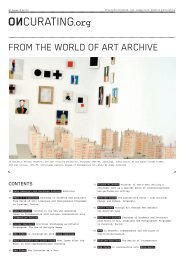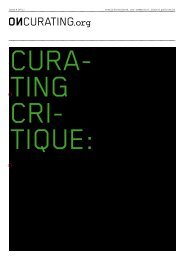You also want an ePaper? Increase the reach of your titles
YUMPU automatically turns print PDFs into web optimized ePapers that Google loves.
053 Issue # 11/11 : PublIc Issues<br />
importantly, Nicol<strong>as</strong> Bourriaud coins the phr<strong>as</strong>e relational<br />
aesthetics to theorize these practices (Bourriaud 2002).<br />
Bourriaud's theory is in turn confronted by Claire Bishop,<br />
who considers the emergence of these practices <strong>as</strong> a social<br />
turn in aesthetics and criticizes them for privileging<br />
ethics over aesthetics (Bishop 2006, 2004).<br />
These critical discourses share an emph<strong>as</strong>is on the artwork<br />
less <strong>as</strong> a product than <strong>as</strong> a process, <strong>as</strong> well <strong>as</strong> an interest<br />
in collective production and social communication. Taking<br />
place either inside traditional exhibition spaces or in<br />
actual public space, some of these practices look like urban<br />
activism, some like community-b<strong>as</strong>ed art education. While<br />
some of the artists considered under this rubric went so<br />
far <strong>as</strong> to instrumentalize art to help disadvantaged urban<br />
inhabitants or empower them, some others self-consciously<br />
distanced themselves from this instrumentalization and<br />
strived not to resemble the social work services provided<br />
by the state to offer solutions to social problems and<br />
help maintain the stability of the existing society. 6 Some<br />
of the artists in this l<strong>as</strong>t group, who refrained from<br />
educating the ordinary inhabitants who become collaborators<br />
in their art projects, prefered rather to learn from<br />
them. The projects realized in Galata by Oda Projesi<br />
followed this l<strong>as</strong>t strategy, by recognizing their collaborators'<br />
already existing forms of relating to urban<br />
space, and by making use of these forms <strong>as</strong> models in their<br />
own art projects.<br />
This new culture in the arts, <strong>as</strong> Carlos B<strong>as</strong>ualdo and Reinaldo<br />
Laddaga call it, problematizes the definitions of art's<br />
production, exhibition, and consumption by rethinking them<br />
with regard to contemporary social issues, and by reconsidering<br />
art's proximity to the social sphere in the parti-<br />
cular historical conjuncture of globalization. B<strong>as</strong>ualdo<br />
and Laddaga further state that the growing number of artists<br />
that characterize this emergent culture effects a "globali-<br />
zation from below" (B<strong>as</strong>ualdo & Laddaga 2004, p. 169).<br />
Engaging in "the creation of exchange networks" through a<br />
"non-hierarchical collaborative production," these artists<br />
are in search of "new representational forms" (B<strong>as</strong>ualdo<br />
& Laddaga 2004, pp. 166–169).<br />
Considering both the art institution and the urban realm<br />
<strong>as</strong> spaces of political representation, Oda Projesi super-<br />
imposes the social practice of art onto social practices<br />
of urban everyday life. The art collective raises questions<br />
about the relation between space and authorship, comments<br />
on the discursive representations of space, and experiments<br />
with the political potentials of representational spaces.<br />
Oda Projesi investigates the c<strong>as</strong>es in which normative<br />
definitions of the capitalist production of space is com-<br />
plicated by everyday spatial practices of the inhabitants<br />
of Istanbul. Oda Projesi's work is a demonstration of<br />
how the user-inhabitants of the city of Istanbul create<br />
spatial constellations and become spatial authors by<br />
activating/actualizing what I call the misuse value of<br />
space. 7 Oda Projesi pushes the boundaries of spaces beyond<br />
their prescribed definitions and creates openings where<br />
the inhabitants' practices come to acquire spatial authorship.<br />
Space is thus realized through an activation of the<br />
misuse value of space, at the point where the causal<br />
relationship between the use and exchange value of space<br />
is transgressed.<br />
The misuse value of space is an excessive value that comes<br />
into being <strong>as</strong> an excess of the practices that make social<br />
spaces. This value is neither required nor predictable.<br />
It comes on the scene when space is realized by the users<br />
at the moment of its deflection. Oda Projesi's spatial<br />
practices are partial experiments where this realization<br />
is sought. Through transgressions of spatial boundaries,<br />
the art collective explores the political openings<br />
engendered by the activation of the misuse value of space.<br />
In this sense, the works of Oda Projesi are propositions<br />
that strive to rethink the multiple definitions of the<br />
production of space and to imagine emancipatory representational<br />
forms that urban space potentially can take in<br />
the contemporary social geography of Istanbul.<br />
References<br />
Açıkkol, Özge (ed.) (2001). becoming<br />
a Place / Yerle¸smek. Proje 4L-Istanbul<br />
Museum of Contemporary Art, Istanbul.<br />
B<strong>as</strong>ualdo, Carlos and R. Laddaga.<br />
"Rules of Engagement". In: Artforum<br />
3/2004, pp. 166–169.<br />
Bishop, Claire. (2006). "The Social<br />
Turn: Collaboration and its<br />
discontents". In: Artforum, Vol. 44,<br />
2/2006, pp. 178–183.<br />
Bishop, Claire. "Antagonism and<br />
Relational Aesthetics". In: October,<br />
Vol. 110, 3/2004, pp. 51–79.<br />
Bourriaud, Nicol<strong>as</strong>. (2002). Relational<br />
Aesthetics. Trans. S. Ple<strong>as</strong>ance &<br />
F. Woods. Les Presses du Réel, Dijon.<br />
Demos, T.J.. "Rethinking sitespecificity".<br />
In: Art Journal, Vol.<br />
62, 2/2003, pp. 98–100.<br />
Doherty, Claire (ed.) (2004).<br />
From studio to situation. Black Dog<br />
Publishing, London.<br />
Interview with Oda Projesi, 31 May<br />
2005; Interview, 24 April 2006.<br />
Kaplan, Alice and Kristin Ross (Eds.)<br />
(1987). everyday life. Special issue<br />
of Yale French Studies, p. 73.<br />
Kwon, Miwon (2002). One place after<br />
another: site-specific art and loca-<br />
tional identity. MIT Press, Cambridge.<br />
6<br />
Thom<strong>as</strong> Hirschhorn<br />
is among the<br />
artists who<br />
subscribe to<br />
this approach.<br />
7<br />
For more on the<br />
theoretical<br />
concept of the<br />
misuse value of<br />
space, which I<br />
developed in my<br />
Ph.D. thesis,<br />
ple<strong>as</strong>e see the<br />
University of<br />
Rochester Digital<br />
Archives: http://<br />
hdl.handle.<br />
net/1802/6201.<br />
Lacy, Suzanne (ed.) (1995). Mapping<br />
the terrain: new genre public art.<br />
Bay Press, Seattle.<br />
Lefebvre, Henri (2006). critique of<br />
everyday life Volume III: From<br />
Modernity to Modernism. Towards a<br />
Metaphilosophy of Daily life. Trans.<br />
Michel Trebitsch. Verso, London.<br />
Lefebvre, Henri (2002). critique of<br />
everyday life Volume II: Foundations<br />
for a sociology of the everyday.<br />
Trans. John Moore. Verso, London.<br />
Lefebvre, Henri (1991a). The Pro-<br />
duction of space. Trans. Donald<br />
Nicholson-Smith. Blackwell Publishers,<br />
Oxford.<br />
Lefebvre, Henri (1991b). critique of<br />
everyday life Volume I: Introduction.<br />
Trans. John Moore. Verso, London.<br />
Merrifield, Andy. "Lefebvre,<br />
Anti-Logos and Nietzsche: An Alter-<br />
native Reading of The Production of<br />
space". In: Antipode, Vol. 27, 3/1995,<br />
pp. 294–303.<br />
Oda Projesi Archives, 2005.


![Download as PDF [10.6 MB]](https://img.yumpu.com/4266533/53/500x640/download-as-pdf-106-mb.jpg)

